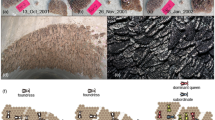Abstract
After landing at the end of their nuptial flight, young queens of the harvester ant Messor semirufus search for a suitable nesting site and dig a burrow. After 3 months in the burrow, they start laying eggs, and nurse their first brood of workers alone. Field observations indicate that a few newly dug burrows contain more than one queen. Laboratory experiments were conducted in order to discover why these young queens’ associations form. We found that groups do not exhibit any productive advantage over single-founding queens, either with respect to progeny number, or with respect to the time until the first eggs are laid. Groups have a slower rate of nest digging than single queens, and mortality rate is considerably higher for queens in groups than for single queens. From the initiation of the group, queen interactions involve aggression and a behavioral hierarchy, with a prior-residence advantage. The tendency to form groups is stronger if queens density is greater and if digging conditions, characterized by soil hardness, are less favorable. We conclude that foundress associations in M. semirufus are in fact the result of nest invasions in an attempt to displace the resident queen. These are motivated by the high cost of the search for a suitable nesting site and of the digging of the nest.



Similar content being viewed by others
References
Agresti A (1992) A survey of exact inference for contingency tables. Stat Sci 7:131–153
Bartz SH, Hӧlldobler B (1982) Colony founding in Myrmecocystus mimicus wheeler and the evolution of foundress associations. Behav Ecol Sociobiol 10:137–147
Bernasconi G, Strassmann JE (1999) Cooperation among unrelated individuals: the ant foundress case. TREE 14:477–482
Cahan S, Helms KR, Rissing SW (1998) An abrupt transition in colony founding behaviour in the ant Messor pergandei. Anim Behav 55:1583–1594
Cahan S, Julian GE (1999) Fitness consequences of cooperative colony founding in the desert leaf-cutting ant Acromyrmex versicolor. Behav Ecol 10:585–591
Clark RM, Fewell JH (2014) Social dynamics drive selection in cooperative associations of ant queens. Behav Ecol 25:117–123
Helms Cahan S, Fewell JH (2004) Division of labor and the evolution of task sharing in queen associations of the harvester ant Pogonomyrmex californicus. Behav Ecol Sociobiol 56:9–17
Hӧlldobler B, Wilson EO (1977) The number of queens: an important trait in ant evolution. Naturwissenschaften 64:8–15
Hӧlldobler B, Wilson EO (1990) The ants. Belknap Press, Cambridge
Jeanson R, Fewell JH (2008) Influence of the social context on division of labor in ant foundress associations. Behav Ecol 19:567–574
Johnson RA (2000) Water loss in desert ants: caste variation and the effect of cuticle abrasion. Physiol Entomol 25:48–53
Johnson RA (2004) Colony founding by pleometrosis in the semiclaustral seed-harvester ant Pogonomyrmex californicus (Hymenoptera: Formicidae). Anim Behav 68:1189–1200
Lehmann EL (1975) Nonparametrics: statistical methods based on ranks. Holden–Day, San Francisco
Maynard Smith J (1977) Parental investment: A prospective analysis. Anim Behav 25:1–9
Maynard Smith J, Parker GA (1977) The logic of asymmetric contests. Nature 24:159–175
Mintzer A (1979) Colony foundation and pleometrosis in Camponotus (Hymenoptera: Formicidae). Pan-Pac Entomol 55:81–89
Mintzer A (1987) Primary polygyny in the ant Atta texana: number and weight of females and colony foundation success in the laboratory. Insectes Soc 34:108–117
Motro M, Motro U, Cohen D (2016) Decision making by young queens of the harvester ant Messor semirufus while searching for a suitable nesting site. Insectes Soc 63:615–622
Nonacs P (1992) Queen condition and alate density affect pleometrosis in the ant Lasius pallitarsis. Insectes Soc 39:3–13
Overson R, Gadau J, Clark RM, Pratt SC, Fewell JH (2014) Behavioral transitions with the evolution of cooperative nest founding by harvester ant queens. Behav Ecol Sociobiol 68:21–30
Pfenning DW (1995) Absence of joint nest advantage in desert seed harvester ants: evidence from a field experiment. Anim Behav 49:567–575
Reber A, Meunier J, Chapuisat M (2010) Flexible colony-founding strategies in a socially polymorphic ant. Anim Behav 79:467–472
Rissing SW, Pollock GB (1986) Social interaction among pleometrotic queens of Veromessor pergandei (Hymenoptera: Formicidae) during colony foundation. Anim Behav 34:226–233
Rissing SW, Pollock GB (1987) Queen aggression, pleometrotic advantage and brood raiding in the ant Veromessor pergandei (Hymenoptera: Formicidae). Anim Behav 35:975–981
Schwarz MP, Tierney SM, Rehan SM, Chenoweth LB, Cooper SJB (2011) The evolution of eusociality in allodapine bees: workers began by waiting. Biol Lett 7:277–280
Thorne B (1982) Multiple primary queens in termites: phyletic distribution, ecological context, and a comparison to polygyny in Hymenoptera. In: Breed MD, Michener CD, Evans HE (eds) The biology of social insects. Westview, Boulder, pp 206–211
Tschinkel WR (1993) Resource allocation, brood reduction and cannibalism during colony founding in the fire ant, Solenopsis invicta. Behav Ecol Sociobiol 33:209–233
Tschinkel WR (1998) An experimental study of pleometrotic colony founding in the fire ant, Solenopsis invicta: what is the basis for association? Behav Ecol Sociobiol 43:247–257
Tschinkel WR, Howard DF (1983) Colony founding by pleometrosis in the fire ant, Solenopsis invicta. Behav Ecol Sociobiol 12:103–113
Acknowledgements
We thank Prof. Michael D. Breed, two anonymous reviewers, and the late Dr. Raja Szlep for important comments and suggestions.
Author information
Authors and Affiliations
Corresponding author
Rights and permissions
About this article
Cite this article
Motro, M., Motro, U. & Cohen, D. Forced associations by young queens of the harvester ant Messor semirufus during colony founding. Insect. Soc. 64, 179–187 (2017). https://doi.org/10.1007/s00040-017-0551-1
Received:
Revised:
Accepted:
Published:
Issue Date:
DOI: https://doi.org/10.1007/s00040-017-0551-1




